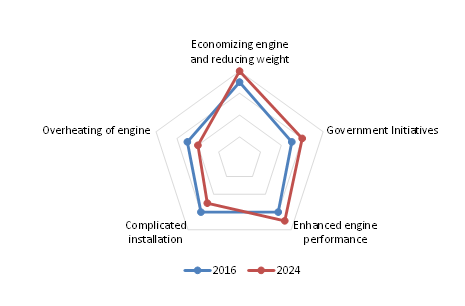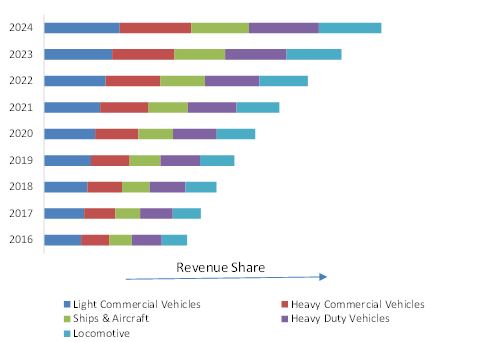Turbocharger Market Revenue Will Reach $24.07 Billion By 2024
The global turbocharger market revenue was valued at $10.2 billion in 2016, and is projected to reach $24.07 billion by 2024, growing at a CAGR of 11.6% from 2017 to 2024. In 2016, the diesel turbocharger segment held the highest revenue share of nearly 57% of the global turbocharger market share.
Market Determinants

Market Determinants – Impact Analysis (2016 – 2024)
Improved engine economization, stringent government regulations and enhanced engine performance & fuel efficiency are the major advantages of the turbochargers which are acting as driving agents to the turbocharger market. Complicated installation of turbocharger and Overheating of engine are restraints. Growing demand for fuel efficient and gasoline engines prominent opportunities. Moreover, the use of turbochargers for conventional IC engines ensure complete fuel combustion which reduces harmful emissions which can severely degrade the environment. However, turbochargers are expensive as compared to the traditional chargers and can overheat the engine, which can act as a major restraints to the market growth. In addition to this, inclination towards electric vehicles or (BEVs) is promoting the auto industry in their shift from combustion engines to electricity powered vehicles which will eventually hinder the growth of turbocharger market. On the other hand, growing demand for fuel efficient and gasoline engines can bring future growth opportunities for the industry.
Twin turbo technology emerged out as the most adopted technology for turbochargers.
The twin-turbo also called as bi-turbo refers to a turbocharged engine in which two turbochargers compress the intake charge and use it for the combustion. As a result of less piping requirement and reduced turbo lag, the twin turbo market held approx. 44% of the overall turbocharger market in 2016 and is witnessed to dominate the market throughout the forecast period of 2017-2024, having a CAGR of 10.8%. However, the variable geometry turbochargers are expected to experience the fastest growth having a CAGR of 12.3% during the entire forecast period. This is a result of certain emerging advantages of variable geometry turbochargers. According to a research done by International Journal of Trend in Research and Development (IJTRD), variable geometry turbochargers (VGT) can increase the charged air mass by 10-20%, increase the torque by 40% and considerably reduce the exhaust smoke due to complete fuel combustion.
With innovations in technology, Diesel turbochargers would receive a higher adoption.

GLOBAL TURBOCHARGER MARKET BY APPLICATION
Diesel turbochargers are ruling the overall turbocharger market owing to low cost of diesel and higher fuel efficiency. Diesel is up to 30 percent more fuel efficient than gasoline, and it already dominates many markets in Europe, where fuel is more expensive. Exponential rise in demand of cost-effective and fuel-efficient engines has led to a higher adoption of turbocharger across industries such as automotive, marine, and aerospace & defense. The diesel turbocharger market is expected to witness a CAGR of 11.8% during the forecast period.
Light commercial Vehicle turbochargers will dominate the entire market throughout the forecast period holding nearly 1/4th of the total market share in 2016. This is a result of hiked LCV production all over the globe, especially in Europe and Asia Pacific.






